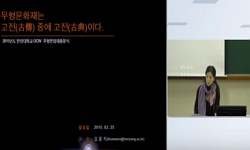본고에서는 우리나라의 문화재보호법에 규정된 원형(原型)보존주의의 원칙이, 무형문화재의 보존과 활용에 미치는 부정적인 부분을 지적하고, 이를 해소하기 위하여, 지금까지 적용되어 오...
http://chineseinput.net/에서 pinyin(병음)방식으로 중국어를 변환할 수 있습니다.
변환된 중국어를 복사하여 사용하시면 됩니다.
- 中文 을 입력하시려면 zhongwen을 입력하시고 space를누르시면됩니다.
- 北京 을 입력하시려면 beijing을 입력하시고 space를 누르시면 됩니다.

무형문화유산(無形文化遺産)의 보존(保存)과 활용(活用)에 대한 소고(小考) -전형(典型)의 개념을 중심으로- = A Study on Preservation and Utilization of Intangible Cultural Heritage -Centering on a Concept of a Pattern(典型)-
한글로보기https://www.riss.kr/link?id=A101720393
- 저자
- 발행기관
- 학술지명
- 권호사항
-
발행연도
2008
-
작성언어
Korean
-
주제어
원형 ; 原型 ; 원형 ; 原形 ; 전형 ; 典型 ; 무형성 ; 無形性 ; 무형문화유산 ; 무형문화재 ; archetype ; original form ; typifier ; intangibility ; intangible cultural heritage ; intangible cultural properties
-
등재정보
KCI등재
-
자료형태
학술저널
-
수록면
217-241(25쪽)
- 제공처
-
0
상세조회 -
0
다운로드
부가정보
국문 초록 (Abstract)
본고에서는 우리나라의 문화재보호법에 규정된 원형(原型)보존주의의 원칙이, 무형문화재의 보존과 활용에 미치는 부정적인 부분을 지적하고, 이를 해소하기 위하여, 지금까지 적용되어 오던 원형(原形) 개념 대신 전형(典型) 개념의 도입 필요성과 적합성을 제기하고자 했다. 전형(典型) 개념의 도입은 원형(原形) 개념의 단절성(斷絶性)과 고착성(固着性)을 완화하여 문화의 연속성과 내발적(內發的) 생동성을 제고함으로써 무형문화유산의 효율적인 보존과 활용의 기저(基底)를 견고히 하려는 시도이다. 본문에서 기술한 바와 같이 무형문화유산에 유형(有形)의 개념인 원형(原形)을 사용하는 것은 논리적으로 맞지 않다. 또 지정 당시의 형태만을 원형(原形)으로 보존하고 관리 하는 것은, 그것에 내재(內在)되어 있는 전형성(典型性)을 간과하는 것이다. 전형(典型)은 원형(原型)을 기반으로 해서 만들어진다고 상정(想定)된다. 따라서 전형성(典型性)을 보장하는 것은, 문화유산의 생성기반이 되었던 원형(原型)을 지역적·역사적·사회적 배경이나 그 구성·행위원리와 함께 고려하는 것이다. 아울러 본문에서 제기한 문화유산의 ‘무형성(無形性)’은 무형문화유산 뿐만 아니라 유형문화유산 분야에서도 중요하게 고려되어야 한다. 무형문화유산의 효율적인 보존과 활용은 유형문화유산의 보존과 활용에도 밀접한 영향을 끼치기 때문이다. 무형문화유산은 대부분 ‘구조화된 행위원리의 틀’을 기저부에 가지고 있다. 그것이 행위의 형태로 나타나면 무형의 문화유산이고, 행위의 결과물로서 나타나면 유형의 문화유산이 되는 것이다. 이런 ‘구조화된 행위원리의 틀’은 우리가 상정하는 원형(原型)이라고 할 수 있다. 따라서 무형문화유산의 보존과 활용이 우리 민족의 문화원형(文化原型)과 연관되어 전개되는 것이 바람직하다고 생각한다면, 무형문화유산의 보존과 활용에 있어서 중심적으로 다루어져야 할 대상은, 행위의 결과로 만들어지는 ‘형태’가 아니라 그것을 생산해내는 ‘원리’라고 말할 수 있을 것이다.
다국어 초록 (Multilingual Abstract)
This study is to point out that the original form protection principal prescribed by Korea``s Cultural Properties Protection Law has had a negative effect on the protection and application of intangible cultural assets and to solve the problem by sugg...
This study is to point out that the original form protection principal prescribed by Korea``s Cultural Properties Protection Law has had a negative effect on the protection and application of intangible cultural assets and to solve the problem by suggesting the necessity of introducing a new concept such as ``typifier`` into our cultural protection policy. The purpose of Introducing a ‘typifier’ concept into the present policy is to strengthen the basis of effective protection and application of intangible cultural assets by mitigating a sense of estrangement fixation which an original form concept innately has and by highlighting both the continuity and spontaneous vitality of culture. As described in the study, it is not logical to use the ‘original form’ concept which needs forms in protecting intangible cultural assets. In addition, protecting and controlling the first designated type as an original form causes a serious problem in that it can never solves the intrinsic typification of intangible cultural assets. A typifier is produced based on an archetype. Accordingly, the acceptance of the typification of intangible cultural assets helps us consider an archetype, the creation basis of cultural assets, in the regional, historical, and social backgrounds and by the structure and act principle. The formlessness of cultural assets should be considered important in not only intangible cultural assets but also tangible cultural assets because they both have a great influence on each other. The intangible cultural assets have ‘a structured frame of act principle’ in their base. An act principle shown in an act is an intangible cultural asset, while that in an outcome of an act is a tangible cultural asset. This structured frame of act principle is namely an archetype. If the protection and application of intangible cultural assets should be done in relation to the cultural archetype, the most important factor we have to consider is not a ‘form,’ an outcome of an act but a ‘principle’ which produces a form.
동일학술지(권/호) 다른 논문
-
- 남도민속학회
- 강정원 ( Jeong Won Kang )
- 2008
- KCI등재
-
- 남도민속학회
- 로저자넬리 ( Rofer I. Janelli )
- 2008
- KCI등재
-
중국민속학사 : 중국민속학사상(中國民俗學思想)의 발전(發展)
- 남도민속학회
- 류철량
- 2008
- KCI등재
-
- 남도민속학회
- 류철량 ( Tie Liang Liu )
- 2008
- KCI등재




 KCI
KCI KISS
KISS






